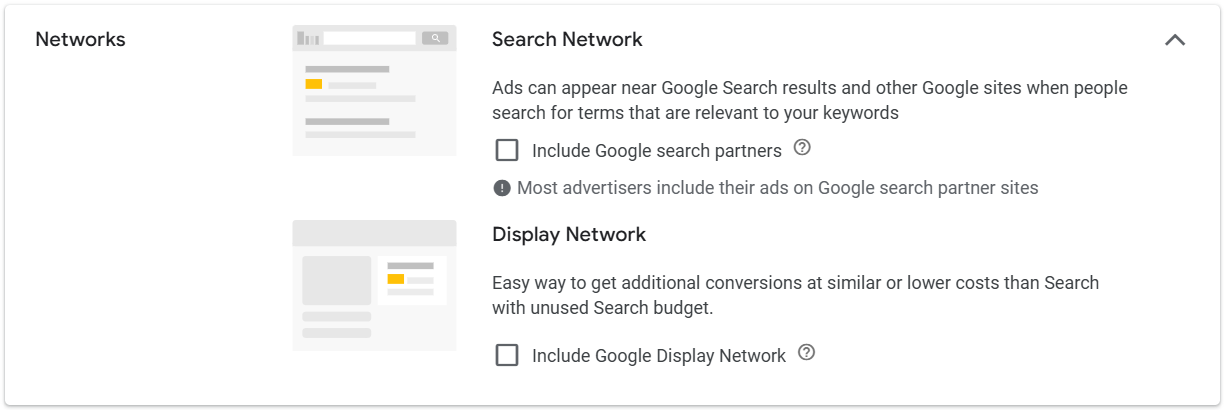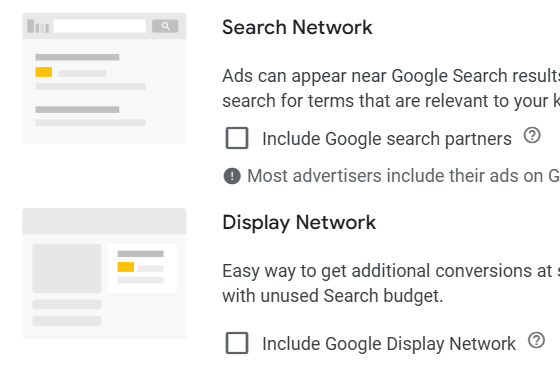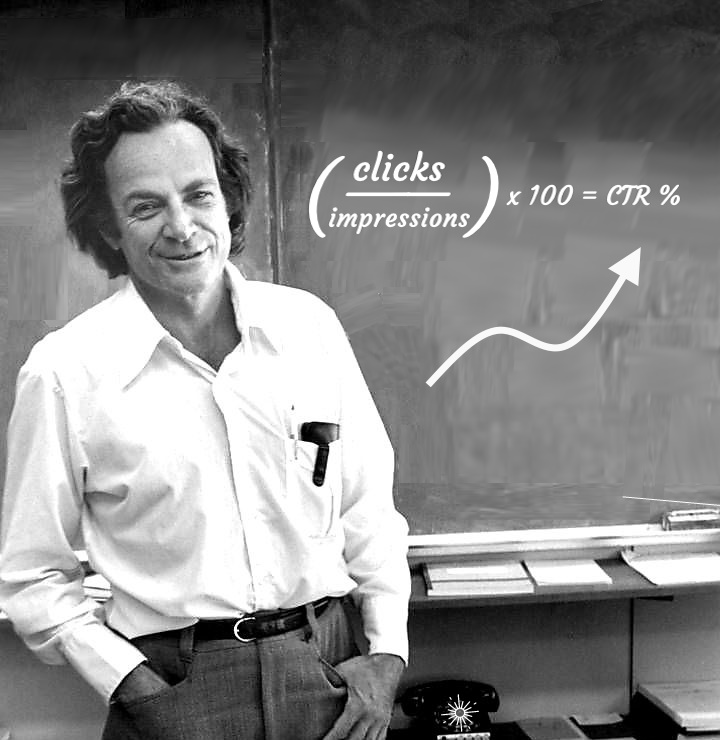Brand or no brand?
A very important distinction when assessing the value of a given click-through rate is whether the traffic was driven by branded keywords or unbranded keywords.
Broadly speaking, branded traffic from Search campaigns often has a click-through rate at or near 20% (they already know you) while unbranded traffic tends to click-through at a rate between 3% and 5% (mostly new users who are not familiar with your brand). So, if 80% of your clicks come from branded traffic and just 20% of them come from unbranded traffic, you'll end up with a sparkling blended CTR%.
Branded traffic is important for a few reasons, but it does not typically represent new customers. If you are hearing about your company's fantastic click-through rate in your monthly reports, ensure that you know how much of that glowing figure is based on branded traffic.
Is it a standard Search campaign?
As of 2025, Google Ads features no fewer than seven different campaign types including Search, Display, Video, Performance Max, and a few others. Each of these campaign types have different settings and features and thus produce markedly different click-through rates.[1]
For example - if you have a video campaign running, it is likely targeting views. Clicks through a video ad are relatively rare compared to clicks through a Search ad. This can depress an account-wide blended CTR%. Display ad campaigns can also produce anomalous click-through rates - often based on the different goals that drive those types of campaigns.
While click-through rate calculations typically reference Search campaign traffic, it's a good idea to know exactly which campaign types are impacting your metrics.
[1]. To be clear, advertisers using certain campaign types (and by "certain", we mean the ones with limited advertiser control that they really push you to jump into (and by "they", we mean the Google reps that appear like weeds after rain the instant an ad account is funded or activated)) are slowly losing control over metrics like Click Through Rate. Many of the new automation-lathered campaign variants proffered by Google Ads in the past few years (looking at you with a critical glare, Performance Max) rely on signals that are intentionally nebulous, making the optimization of a metric like CTR more and more difficult. When you do have a CTR% from one of these AI-heavy campaign types available to analyze, it is often informed by such a vague melange of data that it can't really be considered a meaningful metric - and certainly not a KPI.
Are there any secondary networks included?


Two of the sneakiest settings lurking within the Google Ads platform are "Include Google search partners" and "Include Google Display Network". Found in Search campaign settings under "Networks", these optional Google Search Partner site and Google Display Network ad placements can be less than ideal for many advertisers.
Data from secondary traffic sources can be more unpredictable than ordinary Search traffic data. These secondary networks can also produce valuable traffic (and acceptable CTRs) on occasion, but should be monitored very closely when opted into.
Which keyword match types are being used?
Keyword match types remain one of the most important and functional aspects of any Google Ads Search campaign. These keyword settings help limit the search queries that a particular keyword matches up with.
Google continues to broadcast the seemingly boundless merits of "broad match" keywords, though seasoned marketers know better. Broad match keywords allow Google to very liberally decide which search queries actually show your ad to a searcher. More traffic is not necessarily a good thing if it is not relevant or valuable to you - especially when it inflates your advertising costs.
Phrase match and exact match keywords allow professional marketers to more effectively control the types of search queries that will ultimately exhaust our clients' budgets. They can also drastically improve campaign click-through rates - especially when paired with negative keywords.
Is any Google automation or AI affecting the traffic?

Several of Google's campaign types and many campaign settings are now built around or enhanced by inchoate AI features [2] - for better or worse. A few of these have logical applications, but many of them are still experimental and can drastically impact campaign performance.
The surreptitious push for extensive platform automation, which has evolved to represent a legitimate affront to strategic digital marketing, has been one of Google Ads' most notorious changes in recent years. Auto-apply settings and experimental AI (more often than not) take away an advertiser's ability to positively affect campaign performance, marketing ROI, and once again...click-through rate. [3]
[2]. Feynman did some interesting and rather prescient riffs on AI - decades before it would enter the popular lexicon. During one, he talks about how magnificant jet airplanes are and how remarkable the technology that makes them fly is. The teams of talented engineers and designers. The complexity of the jet engines, the navigational systems, the aerodynamic nuances, etc. He then deconstructs the fact that the invention of the airplane and the Wright Brothers achieving flight, while a feat of human ingenuity nearly unmatched still to this day, is effectively an attempt by humans to artifically create a bird. An "AI bird" can technically fly (with all of the necessary fuel, within a limited range, if linked to a vast network of satellites and globally synced aerospace systems, and while relying on relatively modest onboard navigational capabilities), but it has a lot of complex moving parts and is difficult and costly to manufacture. A real living bird of any species is superior to even the most advanced aircraft on the planet in almost every way by comparison. (Furthermore, imagine an Airbus A320 flying amicably alongside another large airplane for a bit, then landing somewhere super safe and laying "free" eggs that hatched into tiny perfect brand new A320s)
[3]. Be sure to read the fine print whenever considering opting into AI features and settings. Most digital platforms (Google included) are explicit about the fact that AI-powered systems "can sometimes produce inaccurate or unreliable results". These features should provide more value as the reliability of their outputs improves in the future.
What is the bid strategy? Are there ad assets? What's the ad schedule?
Bid strategies are a critical factor when analyzing campaign results and metrics. Are you deploying a "Maximize clicks" strategy or is it something like "Target impression share"?
Are your ads using ad assets - formerly known as ad extensions? When executed properly, ad assets can improve click-through rates and conversion rates.
What is the ad schedule? Were weekend numbers included? Did seasonal demand influence the numbers? So many factors dictate what a stat like click-through rate really means.
Anyone can tell you that they know CTR = (clicks/impressions)*100. Make sure your ads are being managed by people who understand paid search and not people who simply know what all of the metrics are called.
What is the "industry average" and how did you arrive at that number?

Ahh, the apocryphal "industry average".
The biggest issue with claiming that a number like this exists is that it is almost impossible to prove or validate. Your digital marketing vendor may tell you that your click-through rate was "better than the industry average". Even if true, above average doesn't necessarily mean a whole lot.
Today, if you hit .250 as a Major League Baseball player, you are "above average". [4] That new sushi place that opened up within walking distance of your work and has a 3.1 star rating on over 250 reviews - four of them featuring patrons that specifically called out insect interaction as part of their dining experience - THAT place boasts what is still considered an "above average" rating.
Granted, some marketers have specialized industry knowledge and have a better sense for mocking up a useful "average" specific to metrics in those industries - but claims like these are often slippery. [5]
At Noble Spark, we believe that a better approach is to focus on our own actual data, combine that data with expertise, trends, and deep analysis, and use the output to realize a measurable and sustainable return on investment that improves over time.
Richard Feynman recognized at an early age that developing a thorough understanding and true mastery of some things had far more value than simply knowing the names and surface details of as many things as possible. Click through rate is a reasonably important metric. It's good to know how often your ad impressions result in clicks. Understanding the many different factors that can influence CTR will help you establish how accurate - and how important - yours really is.
[4]. 1968 is known as the "Year of the Pitcher" in Major League Baseball parlance. The batting average for a professional baseball player in 1968 was just .233, still the lowest in the modern era of the sport. Pitchers during this time (the great Bob Gibson being the face of this dominance) were so prolific that both the National and American leagues finished the '68 season with Earned Run Averages under 3.00. (By contrast, in 2024, MLB's overall ERA was 4.07 in what was considered a very strong year for pitchers) Much to the chagrin of accomplished major league hurlers like the aforementioned Gibby - but to the delight of hitters, fans, and media outlets - the pitcher's mound was lowered before the 1969 season to limit the burgeoning effectiveness of the sport's pitchers and improve offensive production in baseball.
[5]. Though he was a creative and eccentric marketer and demonstrated as much when he cut open a live rattlesnake and threw it into a pot of boiling water on stage at the World's Columbian Exposition of 1893 (a world's fair held in Chicago that celebrated the 400th anniversary of Christopher Columbus's arrival in the Americas), Clark Stanley was a historic fraud. His very financially successful product, marketed for more than twenty years under the name "Clark Stanley's Snake Oil Liniment", was ultimately found by federal investigators (in 1916) to contain no snake oil at all. Actual snake oil in the 1800s came from Chinese water snakes, and many of the Chinese laborers who immigrated to the U.S. shared it with fellow workers as they helped build The Transcontinental Railroad. This type of slippery snake oil was indeed an effective anti-inflammatory. Stanley, however, used rattlesnakes (which have much lower Omega-3 fatty acid levels and a much different biological profile) and even then, abandoned the practice early on as it was not cost effective or indeed even logistically plausible (to say nothing of the significant moral implications of this macabre ritual) at the rate he was manufacturing the product - at one point opening production facilities in both Massachusetts and Rhode Island. Clark Stanley wasn't the only shady marketer running a cure-all hustle like this at the turn of the 19th century, but his was prolific enough to forever tie his name to the cautionary tale of the Snake Oil salesman. Editor's note: Noble Spark is fiercely pro-snake in every way imaginable. Snakes are amazing - end of story. (No snakes were harmed during the re-telling of this story.)






